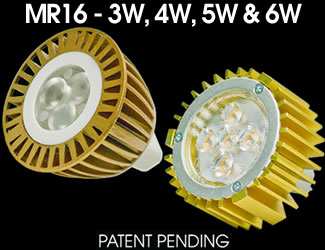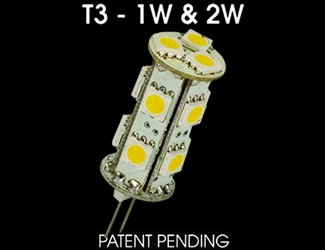 Ever wondered what LED stands for? Well, in low voltage lighting LED means smart, intelligent, brilliant and in some translations, genius! If you’ve ever had a low voltage landscape lighting system that used typical halogen bulbs, you know that the cost and hassle of constantly changing bulbs can sometimes outweigh the benefits of the system. Not to mention the higher electricity costs associated with higher wattage use. There’s no doubt the upfront costs of using LED products are higher than if you were to use comparable halogen products. However, there are other factors to consider in determining if the additional cost is justified. Whether upgrading an existing system or installing a new system altogether, it’s usually only a matter of time before LED bulbs pay for themselves. Below we’ll look at 3 reason why we recommend LED systems in almost every situation.
Ever wondered what LED stands for? Well, in low voltage lighting LED means smart, intelligent, brilliant and in some translations, genius! If you’ve ever had a low voltage landscape lighting system that used typical halogen bulbs, you know that the cost and hassle of constantly changing bulbs can sometimes outweigh the benefits of the system. Not to mention the higher electricity costs associated with higher wattage use. There’s no doubt the upfront costs of using LED products are higher than if you were to use comparable halogen products. However, there are other factors to consider in determining if the additional cost is justified. Whether upgrading an existing system or installing a new system altogether, it’s usually only a matter of time before LED bulbs pay for themselves. Below we’ll look at 3 reason why we recommend LED systems in almost every situation.
1. Bulb Life and Replacement Cost
A typical LED bulb will generally cost about 5 to 10 times more than its halogen counterpart. The difference is that an LED bulb will last 8 to 10 times longer. That may seem like a wash over time, but when you factor service charges on top of material costs for changing bulbs, the benefits are much easier to understand. Halogen bulbs will need to be replaced about every year, whereas an LED bulb would last close to 10 years. Even if you decided to tackle the labor yourself, you’ve still got to figure your time into the equation. Also, given that halogen bulbs have a much smaller window of recommended voltage, it’s not uncommon to see a domino effect of burn outs if you don’t regularly check the system for necessary replacements. In other words, when one bulb burns out, more voltage is being pushed to the remaining lights on that run. Higher voltage means a decrease in bulb life. If the first bulb isn’t

replaced, the second will burn out quicker, and the third even quicker, etc. The moral of the story is, if you choose to go with a halogen system, keep replacement bulbs handy and check the system regularly!
Low voltage lighting is already efficient because it allows you to customize how much light you need in every scenario by choosing from a plethora of fixtures and lamps. However, with LED lamps, you’re using much less wattage for the same light output. A 35 watt halogen MR-16 may be replaced with a 5 or 6 watt LED MR-16. You could use 2 watt LED bi-pins to replace 10 watt halogen bi-pins. The lower the total wattage for your system, the fewer kilowatt hours it will use over the life of the system. As you can see, it’s not uncommon to use 5 times less energy, which means it cost 5 times less to run! Depending on the size of your system, that could add up quickly.

3. Simplified Voltage Distribution
Without getting too complicated, let’s look as how a low voltage landscape lighting system works. First and foremost, you need a transformer. This transformer will reduce the amount of voltage being sent to the fixtures. Most systems are 12 Volt systems, which means when you plug the transformer into a 120 volt outlet, it has to reduce the voltage down to accommodate the system’s 12 volt requirement. Now, because the fixtures are not all right beside the transformer, wire has to be run from the transformer to each fixture. This distance, along with the number of watts on that run, are used in determining how much voltage loss you’ll have at the light itself. Most transformers have various taps that put out anywhere from 11 to 15 Volts to accommodate for this voltage drop. These calculations are very important in halogen systems in order to ensure maximum bulb life and equal brightness throughout the system. As stated above, higher voltage means less bulb life…but it also means a brighter bulb. The recommended voltage at each light for a halogen bulb is between 10.8 and 11.5. Where 12 Volts would theoretically give you 100% bulb life and 100% brightness, the recommended range allows for a much longer bulb life without loosing too much in the way of brightness. This range for LED lamps is MUCH greater. They can operate anywhere from 10 to 18 Volts without sacrificing bulb life or a noticeable difference in brightness. In addition, the lower wattage on that run means that you’re loosing much less voltage anyhow. This allows you to put more lights on a run, use smaller gauge wire, and in the future you’re less likely to negatively effect the system by adding more lights.
If you’re considering installing a new system, to me it’s a no brainer. LED is the only way to go! If you have a system and you’re trying to decide whether to upgrade to LED lamps, I strongly suggest it. You will save time, money, and aggravation in the long run…guaranteed!
Ready to get started on your Landscape Lighting Project? Contact us now for a free estimate!
Stay tuned for more professional landscaping tips from Hyatt Landscaping, Inc! If you enjoyed this article, please comment below and be sure to “like” us on Facebook. Thanks!!!
